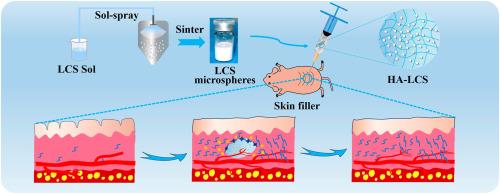An injectable hyaluronic acid/lithium calcium silicate soft tissue filler with vascularization and collagen regeneration
IF 18
1区 医学
Q1 ENGINEERING, BIOMEDICAL
引用次数: 0
Abstract
The significance of collagen and vascular in skin augmentation have been recognized in recent years. However, current skin tissue fillers, e.g. hyaluronic acid (HA) or HA-based hydrogel, fail to meet the perfect augmentation requirements due to their inadequate long-term support effect and the lack of tissue-inducing activity. Herein, an injectable skin filler containing hyaluronic acid (HA) hydrogel and lithium calcium silicate (LCS, Li2Ca4Si4O13) bioceramic microspheres was developed for skin tissue fillers, owing to the excellent biological function of silicate bioceramics. The HA-LCS fillers could be easily injected through a tiny standard medical needle (27 G) with force of less than 36 N, and showed good biocompatibility both in vitro and in vivo. Furthermore, the bioactive ions released from HA-LCS fillers significantly enhanced the expression of vascularization-related genes and collagen-related genes. Importantly, the HA-LCS fillers not only stimulated the regeneration of mature blood vessels, but also promoted collagen secretion in dermal skin and filling area. This study not only presented an injectable filler with enhanced regeneration of blood vessels and collagen, but also provided a new strategy for developing tissue-induced fillers based on bioactive components of silicate bioceramics.

一种可注射的透明质酸/硅酸钙锂软组织填充剂,具有血管化和胶原蛋白再生功能
近年来,人们已经认识到胶原蛋白和血管在皮肤填充中的重要性。然而,目前的皮肤组织填充剂,如透明质酸(HA)或以透明质酸为基础的水凝胶,由于其长期支撑效果不足和缺乏组织诱导活性,无法满足完美的隆胸要求。在此,由于硅酸盐生物陶瓷具有良好的生物功能,我们开发了一种含有透明质酸(HA)水凝胶和硅酸钙锂(LCS,Li2Ca4Si4O13)生物陶瓷微球的可注射皮肤填充剂,用于皮肤组织填充。HA-LCS 填充物可通过微型标准医用针头(27 G)以小于 36 N 的力轻松注入,在体外和体内均表现出良好的生物相容性。此外,HA-LCS 填充剂释放的生物活性离子还能显著增强血管相关基因和胶原相关基因的表达。重要的是,HA-LCS 填充剂不仅能刺激成熟血管的再生,还能促进真皮层皮肤和填充区胶原蛋白的分泌。这项研究不仅提出了一种具有增强血管和胶原蛋白再生能力的注射填充剂,还为开发基于硅酸盐生物陶瓷生物活性成分的组织诱导填充剂提供了一种新策略。
本文章由计算机程序翻译,如有差异,请以英文原文为准。
求助全文
约1分钟内获得全文
求助全文
来源期刊

Bioactive Materials
Biochemistry, Genetics and Molecular Biology-Biotechnology
CiteScore
28.00
自引率
6.30%
发文量
436
审稿时长
20 days
期刊介绍:
Bioactive Materials is a peer-reviewed research publication that focuses on advancements in bioactive materials. The journal accepts research papers, reviews, and rapid communications in the field of next-generation biomaterials that interact with cells, tissues, and organs in various living organisms.
The primary goal of Bioactive Materials is to promote the science and engineering of biomaterials that exhibit adaptiveness to the biological environment. These materials are specifically designed to stimulate or direct appropriate cell and tissue responses or regulate interactions with microorganisms.
The journal covers a wide range of bioactive materials, including those that are engineered or designed in terms of their physical form (e.g. particulate, fiber), topology (e.g. porosity, surface roughness), or dimensions (ranging from macro to nano-scales). Contributions are sought from the following categories of bioactive materials:
Bioactive metals and alloys
Bioactive inorganics: ceramics, glasses, and carbon-based materials
Bioactive polymers and gels
Bioactive materials derived from natural sources
Bioactive composites
These materials find applications in human and veterinary medicine, such as implants, tissue engineering scaffolds, cell/drug/gene carriers, as well as imaging and sensing devices.
 求助内容:
求助内容: 应助结果提醒方式:
应助结果提醒方式:


